Lampshades: design options and selection features

Lampshades are needed not only to protect against too bright colors. Often they play a more decorative function, for example, when elite rattan models are selected or a room is decorated in a certain style. It is necessary to take into account not only the possible variations of the lamps, but also the selection features associated with the manufacturer and the necessary care of the lampshade.
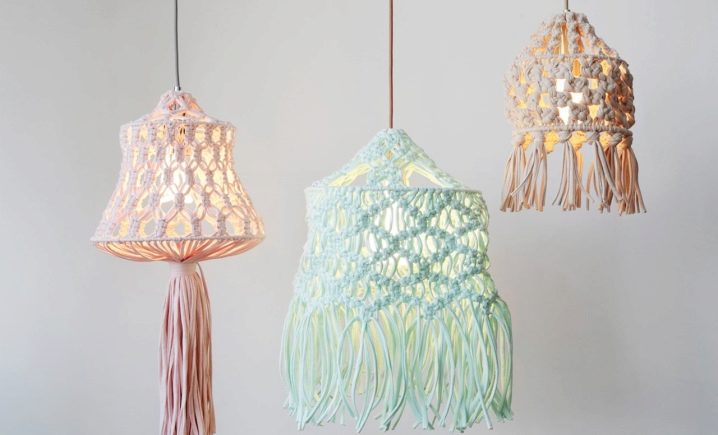
What does it mean and why is it necessary?
A lampshade is a special cap that is worn over a lamp bulb. From French, this word is translated as "dimmer", which immediately indicates its direct purpose: scattering the light flux, softening it through the opaque material of the lampshade. In addition to the main function, such a hood has recently been increasingly used for decorative purposes.
Various materials and shapes in which lampshades can be made allow you to choose the right model for absolutely any style, from refined baroque to deliberately rough rustic.
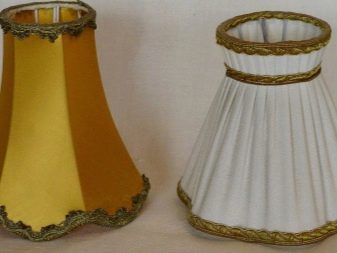

By refracting the light, a lampshade can completely change the atmosphere in a room. It not only diffuses the lighting, but sometimes changes the color of the light flux, passing the rays through itself. In some cases, this looks more than unusual, for example, when it comes to carved lampshades. They transmit light unevenly, creating interesting highlights. They are not suitable as the main light source, but they are best suited for creating a light accent.
Thus, the lamp cover performs many functions, each of which competently complements the other, leaving lampshades among the favorites when choosing lighting. Despite the cumbersomeness, which can often frighten the discerning buyer, such functionality fully pays for the relatively large sizes of lampshades.
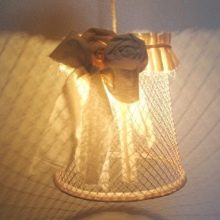
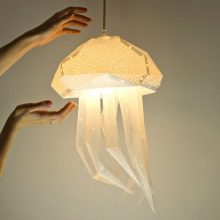
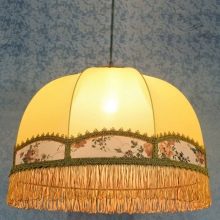
Views
The division of lampshades is carried out according to several criteria, the main of which is the location of the structure.
So, there are ceiling, table and floor options:
- Suspended ceiling lampshade - simple and understandable shape of the lamp. Most often, such a chandelier is used as the main source of lighting and is complemented by LED backlighting due to the inability to create the required amount of light. Such models are performed in different configurations, including design ones for a crystal chandelier lamp.
- Tabletop models differ in a wide variety of sizes and shapes, however, most often they use medium amphora-shaped versions. They prevent light from striking the eyes, even if a table lamp is used as a bedside reading lamp. By the way, speaking of bed lamps, one cannot fail to mention that a lampshade-clothespin for a lamp is often used. It is attached with a clip to the bulb itself.
- Floor samples are a complete replacement for sconces to create local lighting. They can be as high and large as you like. Shades of shades also differ, however, models that are wide at the bottom are most often used.
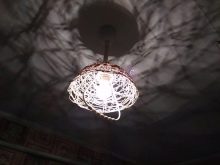
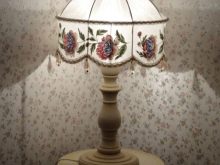
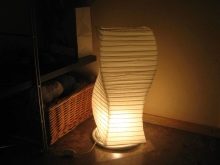
The division by price niches into economy, elite or middle class models is based on the materials that were used to create the lampshades. For example, models made from natural fabrics are a priori at the upper price limit due to the high cost of the raw materials used.
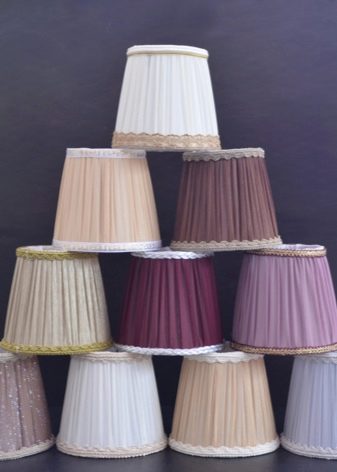
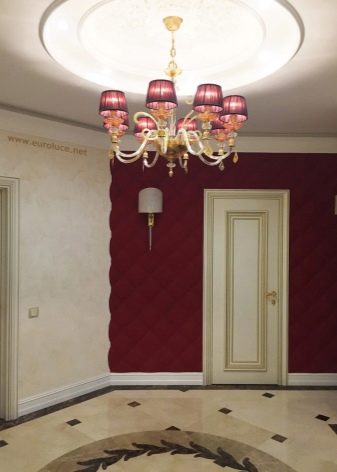
Dimensions (edit)
An indicator of the size of the lampshade is its diameter.There are large, medium and small models:
- Large constructions used as suspended ceiling or floor models. They often play an accent role, attracting attention to themselves. When installing a large floor sample, it is important to pay attention to how harmoniously the size of the plafond is matched to the base. You definitely need to focus on a sense of balance.
- Medium caps well suited for installation under the ceiling, table and floor. If you choose a sample of a suitable shape, it will be possible to diversify the interior with an unusual nuance. Practical medium pendant lamps are mainly installed in functional rooms: kitchens, bathrooms, hallways.
- Mini lampshades complement either multi-track ceiling chandeliers or are used as framing for small reading lamps. Small lampshades are the most "capricious" because they require careful consideration of the choice of lighting element. The small cover is close to the light bulb, so for safety reasons it should not be allowed to heat up quickly.

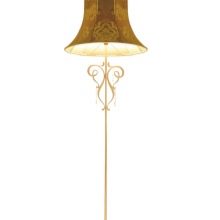
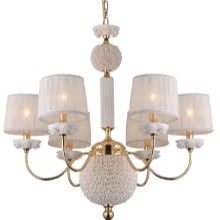
When creating the interior of a room, you can combine lamps with lampshades of various dimensions. Such a technique will help to make the appearance of the room more interesting, make the viewer's eyes dwell on the details.

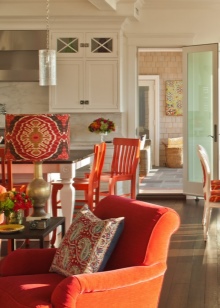
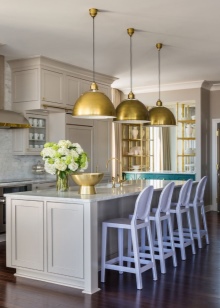
Design
According to their design features, sewn lampshades on the frame and models on a plastic backing are divided.
- In the first case, there is a lot of room for experiments with the form. It will turn out to design not only simple geometric models, but also complex ones. However, these options are not without drawbacks: the presence of a large number of seams cannot be hidden by anything, and in some cases this does not allow creating the necessary atmosphere in the room.
- When designing a lampshade on a backing, there is no need for a complex iron frame, since the backing completely fulfills its role. This is both an advantage and a disadvantage, since there is no possibility of creating a model of a complex shape. For the cap, only one adhesive seam is made on the substrate, and the metal parts-circles for fixing the lampshade are attached only at the bases.
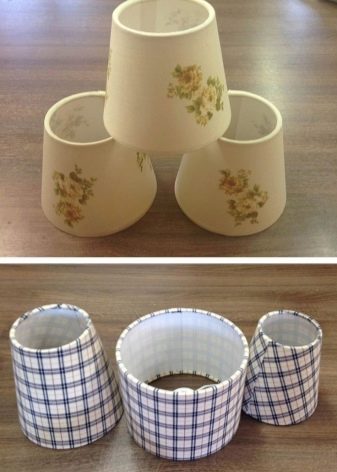

Light lampshades can be attached with a clip to the bulb itself, however, it is much more common to find the option when the attachment is carried out to the upper ring. Fastening to the lower ring is much less common due to the fact that it is used for even forms: a flat cylinder-drum, a cube, and the like.
Heavy models of caps are attached simultaneously to both the lower and upper rings so that the lampshade is fixed as tightly as possible. Basically, the double mount is used for large floor lamps.


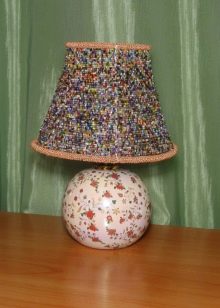
Forms
The variety of configurations is amazing. Along with typical forms, such as a cylinder or a cube, unusual ones are also found everywhere: a concave empire style, a hemisphere with a rim, and others. Classic shapes have rounded corners. These include:
- cylinder;
- concave cylinder;
- round;
- coolies;
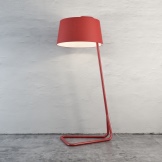



- crinoline;
- direct empire style;
- straight oval;
- concave empire style;
- Tiffany (with or without scallops) and others.
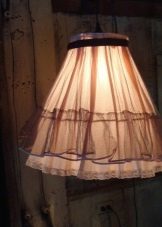
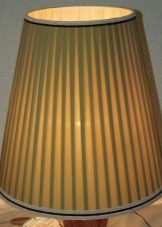

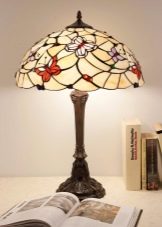
More rectangular models and geometric 3D shapes are often used in modern interiors:
- square option;
- cube;
- ball;
- long cylinder and so on.

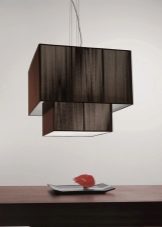

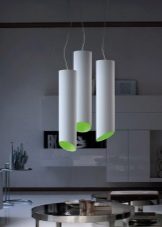
When choosing an option of one form or another, you must definitely focus on the style of the interior, its modernity and spirit. The final appearance of the entire situation largely depends on this.
Also remember that models on different wireframes open up different shape variations. For classic interiors, it is preferable to choose sewn caps with ribs, for modern ones - on a plastic backing. The shapes that open when using these wireframes are optimal for these two main stylistic groups.
It should be noted that today the most versatile is the shape of the cylinder.It can be recreated with a simple frame or with a plastic one, however, the final appearance will be strikingly different.
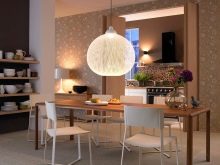
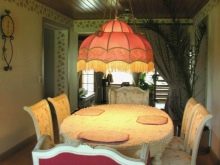
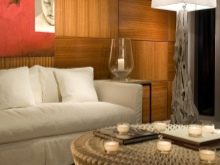
Materials (edit)
When making parts of the lampshade, a variety of materials are used:
- Frame most often do metal, in some cases it can also play the role of decoration. In such situations, the wrought iron frame is not covered by anything from above. For decorative purposes, choose copper, bronze, black materials.
- Plastic backing it can also not be covered with anything, in which case it is at the same time a lampshade. It is possible to form simple geometric shapes, however, you can choose a double-sided color, for example, make the lampshade orange on the inside and gray on the outside.
- Speaking directly about the caps, it can be noted that the most common models are from fabric... They can be either deluxe or affordable. The most expensive models include a fabric silk lampshade. Despite its excellent initial appearance, it quickly loses color and requires frequent replacement.
- Things are a little better with linen cloth. It fits perfectly into almost any interior due to its unusual texture, as well as high wear resistance.
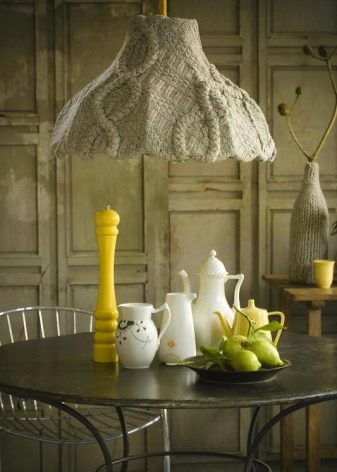
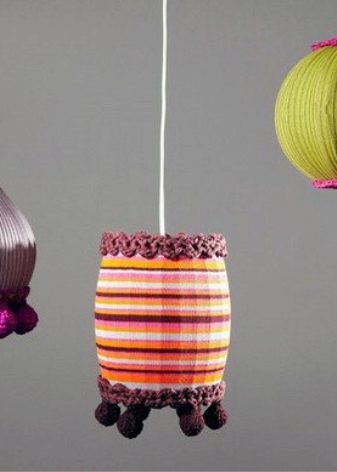
- In oriental interiors, it is used organza... When choosing a fabric, it should be borne in mind that lampshades are made of fabric treated with anti-fire substances, and it is imperative to look for such markings in the characteristics.
- The most interesting models include lace lampshades. They let the light in so that intricate shadows are formed, thereby creating an extraordinary atmosphere.
- Wicker the cap can be made of several materials. More often, there is a wicker model made using the macrame technique, but rattan samples are also widespread recently.
- Glass plafond is a classic of the genre. It can be made of transparent or frosted glass, complemented by a variety of carved details or bubbles. Depending on how frosted the glass is, the scattering power also differs.
- Wood The lampshade is used not only in ecological interiors. You can often find such a model in a sauna or steam bath. Particularly unusual specimens are made with Himalayan salt, as a result they look like large salt crystals.
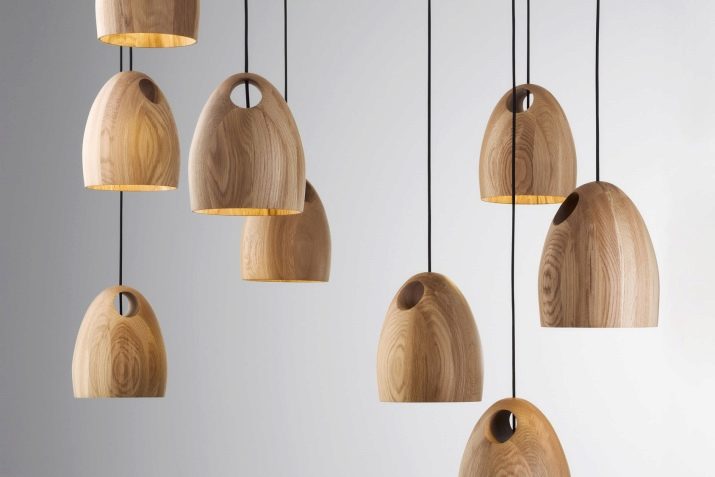
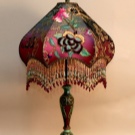
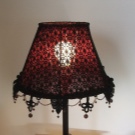
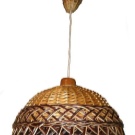
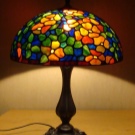
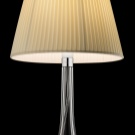
Colors
Both muted models of neutral colors and bright ones are in trend.
The most popular colors include the following:
- Orange;
- purple;
- green;
- Red;
- crimson;
- yellow;
- black;
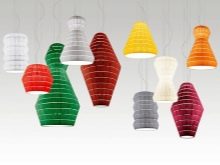

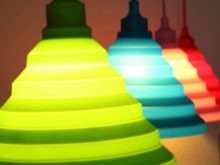
- White;
- turquoise;
- cream;
- light green;
- blue;
- beige;
- transparent;
- silver;
- burgundy.
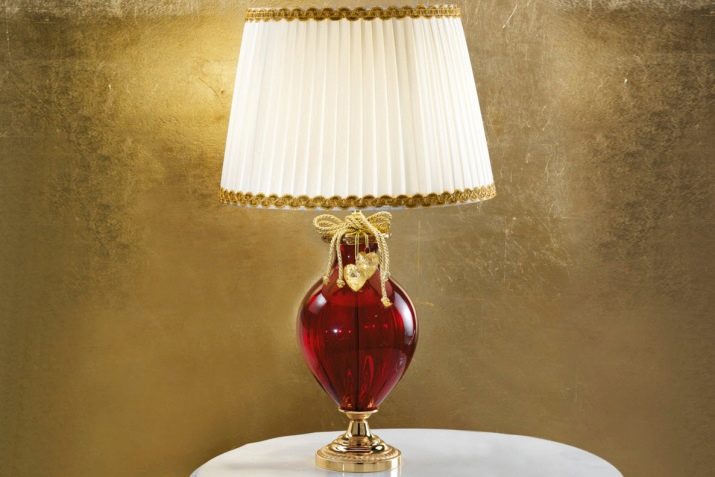
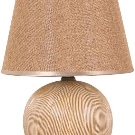
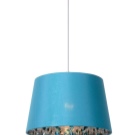
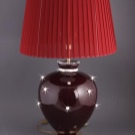

It is customary to make metal forged shades in restrained colors: black, silver and the like. They are usually combined with glass domes. If a fabric model is chosen for metal, it is not necessary to ensure that they are both made in the same color.
Sometimes contrasting combinations look much more interesting, for example, a black metal base and gold fabric.
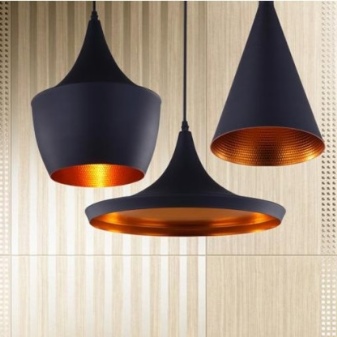

Quite often, not monochromatic lampshades are chosen, but made of fabric with a pattern. In such cases, it is important that the same fabric is repeated in other details of the furnishings, for example, curtains, upholstery of chairs and the like can be sewn from it. To combine various prints, you need to have a subtle artistic flair, otherwise the resulting duet will not produce the desired effect and will look ridiculous.
If you are not confident in your abilities, it is better to abandon the use of a variegated cap in the decoration of the room altogether.

Decor
A simple lampshade often looks boring. You can create an interesting and unique sample yourself. The most unusual way is to update a bored lampshade with decoupage.Using this technique, it will be possible to create the most unusual patterns, because the choice of ready-made options is huge. Decoupage decor is often carried out at home without purchasing additional equipment.
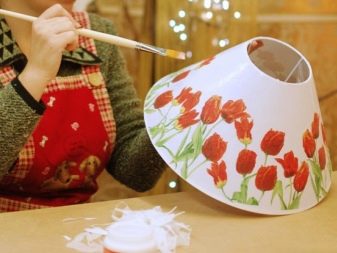
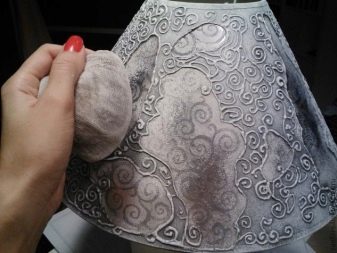
You can add a glamorous look to your lampshade by adding fringe to the bottom edge. At the same time, the fringe can be any, regardless of its type, lampshades with fringes look festive and elegant.
Remember that this type of decorative finish is more preferable for traditional interiors. In most modern rooms, such models will look ridiculous.

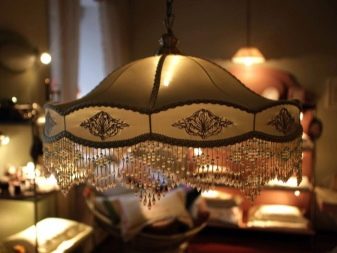
The appliqués embroidered with ribbons over an ordinary plafond will give it a touch of rustic romance. Mostly floral motifs are used, but bows can also be used.
In general, you can decorate lampshades with anything: lace, backstage, bows, appliqués, decoupage, stenciled inscriptions, brushes. The choice of suitable options is limited only by the imagination and taste preferences of the owner.


Styles
Each style has its own preferred lampshade patterns. For some styles, they may overlap or even almost duplicate each other.
We should dwell on several of the most popular areas:
- Provence or shabby chic the choice of "semi-antique" models is welcomed. In general, for country styles, as well as for retro, the choice in favor of aged models, similar to those inherited from older relatives, is characteristic. For Provence and shabby chic, fabric cone-shaped models of light cream color with a large floral pattern are chosen. There are many finishes to choose from: lace, fringe, ribbon embroidery, backstage and the like. The lampshade should look as homemade as possible.
- For models in oriental style an abundance of color is characteristic. Tiffany lampshades, made up of many multi-colored fragments, look interesting. Fabric models are made from translucent multi-colored shawls, as if draped over the frame. The use of luxurious fabrics in bright saturated colors is preferred.
- For loft style it is advisable to completely abandon the use of lampshades, and if you really use any models, you should choose tin or wooden hemispheres.
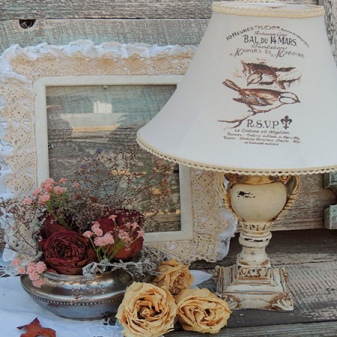

Manufacturers
In the modern market, you can find products from various manufacturers.
- The favorites in the lampshade market are rightfully recognized European models... Italy, Spain, Belgium provide excellent components, not only caps, but bases as well. Separately, the purchase of such elements is much cheaper, at the same time, the design approach guarantees the creation of your own author's model of the lamp.
- Chinese samples often they do not differ in high quality, however, there is an exception for each rule. Factory Chinese lampshades, manufactured in compliance with all the rules and having a certificate of conformity, are quite acceptable in quality, at the same time, their price is significantly lower than for European models.
- Turkish lampshades can rarely be found separately from the bases, mainly the luminaire is supplied as a set. It should be pointed out that the kits are well thought out, of high quality and a fair price. Turkey is on the list of leading countries in the production of lighting fixtures, so Turkish manufacturers are doing their best to live up to such a high rank.
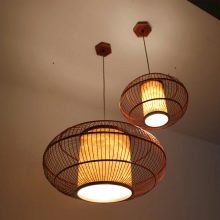
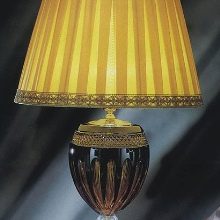

How to choose?
The cap for the luminaire must be selected after repair, when all the details of the situation have already taken their places. The fact is that a pre-purchased floor lamp may simply not fit into the finished interior, and the use of an unsuitable model will nullify all design efforts.
If you are faced with the problem of choosing a hood for furniture, pay attention to the bright upholstered furniture in your room. Typically, a solid shade of the same shade will fit perfectly.
It doesn't matter if it's on the ceiling, on the floor or on the table - this rule works equally well in any situation.
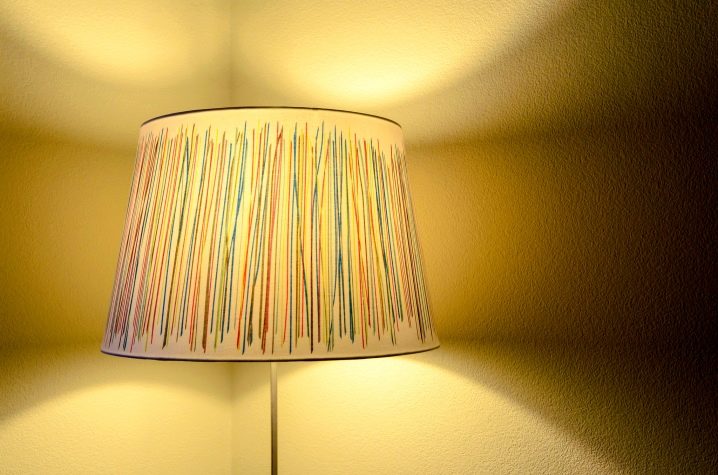
For the nursery, you should opt for bright patterns with drawings, for example, with the characters of the child's favorite cartoon. You can glue applications with different animals, stars, cars on the lampshade.
For the bedroom, it is best to choose neutral models that do not distract from sleep. Low-contrast lampshades are the best choice. For example, in a gray-lemon room, both gray lampshades and light lemon-colored products will look good. It is important to rest your eyes when looking at the lampshade.
Pay attention to the light transmittance of the hood, especially if it is used for a bedside table: the light should not be too bright.
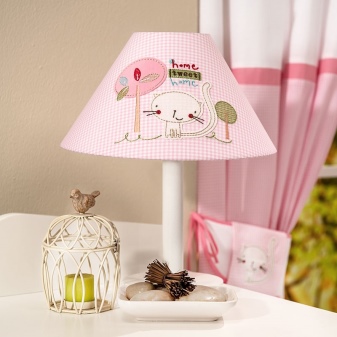
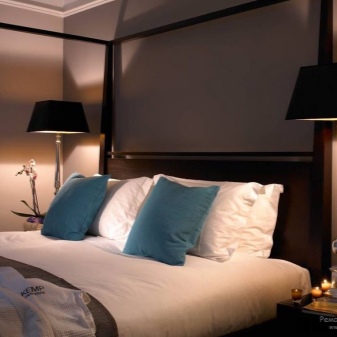
How to care?
Different lampshade materials require different care:
- The simplest thing is to take care of glass models. It is enough just to wipe them with a microfiber cloth, and strong dirt can be removed with a damp cloth. For complete cleaning, it is enough to remove the shades, "bathe" them in a solution of water and dishwashing detergent and polish them with a waffle lint-free towel.
- Wooden lampshades are cleaned with wood polish. Ordinary water is destructive for wood, as it leads to damage to such a delicate material. Also, you cannot use abrasive sponges: they will leave ugly scratches on the lacquered wooden surface, thereby the shade will be hopelessly damaged.

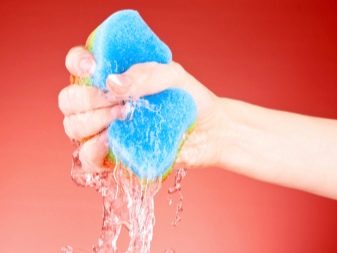
- Fabric options require a more delicate approach. They must be regularly vacuumed to remove dust. It is necessary to use the unit at minimum power, after putting wet gauze on the tube: this way the collected dust will not scatter around the room and will not settle again on the lamp cover.
- Thorough cleaning of the fabric cap is carried out with a sponge dipped in warm soapy water. Places of strong dirt should be wiped, if possible without touching the attachment points of the frame. It is not protected by an anti-corrosion coating, so it can rust.
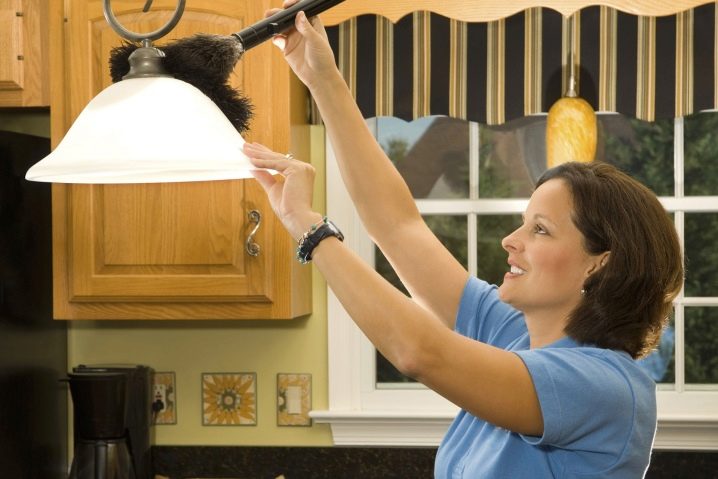
Beautiful interiors
Below are some examples of lampshades that are harmoniously matched to the environment.
When the floor lamp is made from the same fabric as some of the trim pieces, the whole room takes on a more finished look. An ottoman, decorative pillows on a plain, unobtrusive sofa and a floor lamp on an interesting carved base are a wonderful trio.
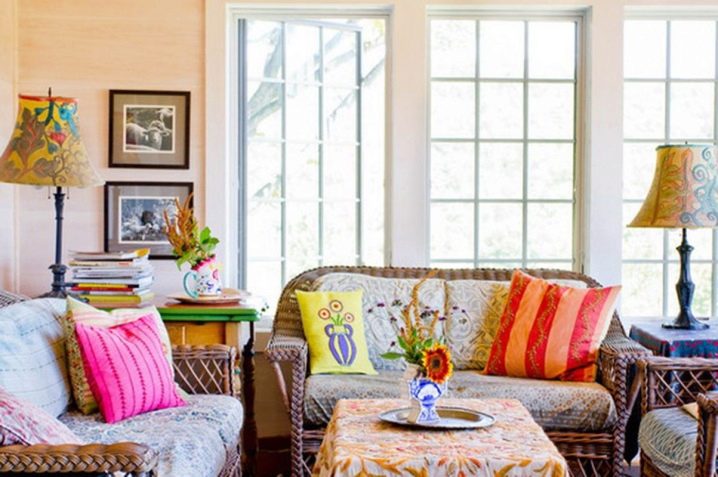
- In Scandinavian-style interiors, it is often the lampshade that is an accent detail, however, it is important to ensure that it does not get out of the way. Pay attention to how the pendant model is combined with the tabletop: the hood is matched to the color of the bases.
- Recently, it has become fashionable to protect large pompous crystal structures with simple cylindrical lampshades. Colors can vary, however, most often white, beige, black, lilac shades are used.
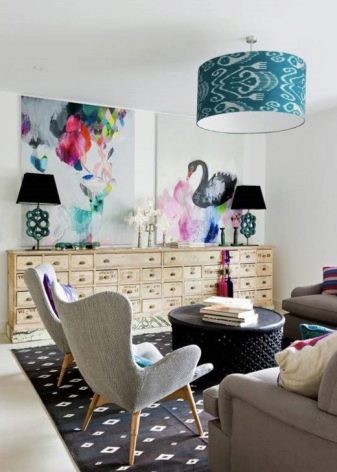
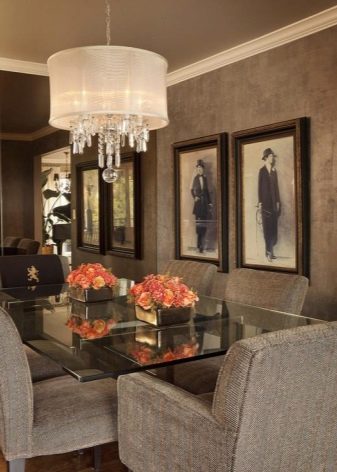
How to make a lampshade with your own hands, see the following video:













The comment was sent successfully.